The M728 full-tracked combat engineer vehicle is designed to provide maximum ballistic protection for the crew and
is heavily armed, being a basic M60A1 tank modified to provide a mobile and maneuverable weapon for combat support
of ground troops and vehicles. The M728 vehicle is used for breaching, obstacle removal, transportation of demolition
teams, and pioneering operations.
Although the M728 consists of a tank hull and a short-barrelled turret, it is not a tank and should not be routinely used against enemy tanks.
It is an excellent heavy assault support vehicle when used as part of a combined engineer-infantry team.
The M728 It is equipped with a hydraulically operated dozer blade (moldboard) mounted to the front of the hull. A winch and boom
are mounted to the turret for lifting, carrying, and winching. Erecting and stowing the boom are accomplished hydraulically.
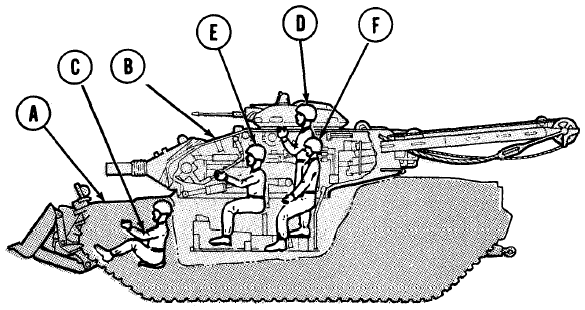
The vehicle is divided into two sections, hull (A) and turret (B).
The hull front contains the driver's (C) compartment, controls and instruments.
The hull rear contains engine, transmission, fuel tanks, and related automotive parts.
The turret (B) has positions for commander (D), gunner (E), and loader (F).
The turret, which fits into the hull opening, is a one-piece homogeneous armor steel casting.
- A platform (turret basket) attached to the turret permits the commander, gunner, and loader to traverse with the turret.
- Openings provided in the turret accommodate the 165mm combination gun mount, commander's cupola, ventilating blower, antennas, boom and winch hydraulic lines, sighting and fire control components and loader's hatch.
- The turret contains electrical and hydraulic controls, communications equipment, sighting and firing controls.
- Externally the turret has racks for stowing miscellaneous items such as a 5-gallon water can, cargo and combat packs, towing cables, water fording equipment and the Xenon searchlight.
- Internal racks are provided for stowage of items such as periscopes, binoculars, flashlights, canteens, rations, a portable carbon dioxide (C02) fire extinguisher, ammunition, and various hand tools.
- A winch-boom assembly is mounted to the turret for lifting, carrying, and winching operations.
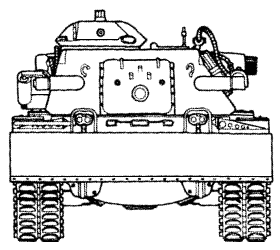
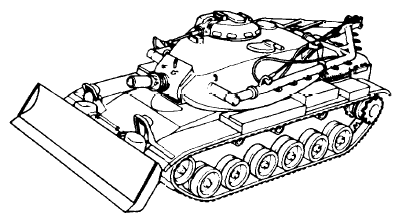
During the Vietnam war, the M728 was used in fire support, base security, counterambush fire, direct assault of fortified positions, and limited reconnaissance by fire.
During Operation Desert Storm, M728s were used to augment M1A1s equipped with mine rollers and mine plows.
165mm AMMUNITION
Ammunition for the M135 165mm gun is issued in fixed complete rounds.
A complete round consists of all ammunition parts needed to fire weapon once.
It consists of an electric primer and propelling charge contained in a cartridge case and a fused projectile.
The cartridge case is threaded onto the base of the projectile.
The term "fixed" used with ammunition means that propelling charge cannot be changed.
A round is loaded into the gun as a unit.
165mm ammunition.
| Model |
Type |
Length |
Weight |
Projectile Weight |
Primer |
Fuze |
| M123E1 |
HEP |
27.62 in (701 mm) |
65.6 lb (29.8 kg) |
62.5 lb (28.3 kg) |
M73 electric |
M62A1E1 BD |
| M623 |
Training |
27.62 in (701 mm) |
65 lb (29.5 kg) |
? |
N/A |
N/A |
M123E1 High Explosive Plastic (HEP)

Olive drab with yellow markings and black band.
M623 Target Practice (TP)
Blue with white markings.
The HEP round is very effective against masonry and concrete targets.
The pushing and heaving effects caused by the HEP round's base detonating fuze and large amount of explosive can demolish barriers and knock down walls.
One round creates a 1 foot (0.3 m) diameter hole in a 7 inch (178 mm) thick reinforced concrete wall.
The round's effects against bunkers and field fortifications are dramatic, often crushing or smashing entire walls.
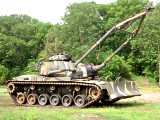
M728, right side
23-OCT-1991
DoD photo by Lou Rivera
1024x768, 266K, JPEG
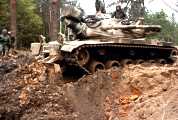
M728 clearing road
Fort Stewart, Georgia
24-OCT-1990
DoD photo by Don Teft
1024x692, 229K, JPEG
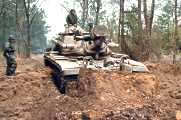
M728 clearing road
Fort Stewart, Georgia
24-OCT-1990
DoD photo by Don Teft
1024x680, 278K, JPEG
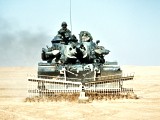
72nd Engineering Company, 24th Infantry Division, testing a mine-clearing rake
Operation Desert Storm
18-FEB-1991
DoD photo by SPC Henry
1024x768, 223K, JPEG
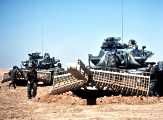
72nd Engineering Company, 24th Infantry Division, testing a mine-clearing rake
Operation Desert Storm
18-FEB-1991
DoD photo by SPC Henry
1024x752, 260K, JPEG
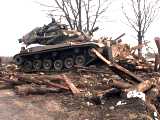
M728 from Charlie Company, 16th Engineer Battalion, 130th Brigade, demolishes a Bosnian Serb bunker
Operation Joint Endeavor
Route "Arizona", near Dubrave, Bosnia
10-JAN-1996
DoD photo by SSG Brian Cumper
1024x768, 297K, JPEG




 Olive drab with yellow markings and black band.
Olive drab with yellow markings and black band.
